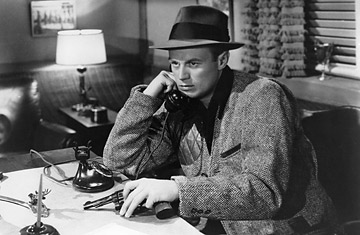
Richard Widmark in a scene from the film Kiss of Death.
The gentleman was a goon. Richard Widmark, whose death on Monday was announced by his wife Susan Blanchard, had one of the grisliest, most electrifying debuts in movie history. In the 1947 Kiss of Death, he played the psychopathic Tommy Udo, maniacally giggling as he pushed a wheelchair-bound old lady down the cellar stairs to her death. This sort of violence, explosive and explicit, was startling in early postwar films, as were the insane delight glinting in the killer's eye, the sexual thrill in his catarrhal voice. But that was just acting — glorious acting — for Widmark was a well-liked, well-mannered, essentially private star, a gentleman of the old school.
See scenes of Widmark as Tommy Udo:He was 32 before he got into movies. Born in Sunrise, Minn., he got the theater bug at Illinois' Lake Forest College and stayed on to teach acting. From 1943 to 1946 he appeared in five Broadway plays, none lasting as long as four months, before coming to Hollywood. Director Henry Hathaway thought the actor too clean-cut to play Udo, but Darryl Zanuck, the boss of 20th Century-Fox, detected psychological turbulence beneath Widmark's stark, chiseled features, and the role was his, for life. It earned him the sobriquet "the face of film noir" and his only Oscar nomination.
Like Humphrey Bogart, Widmark started in movies as a thug and only gradually graduated to hero status. He was a murderously jealous cafe owner in Road House and a racist punk, spilling out vile epithets to noble young black doctor Sidney Poitier, in No Way Out (where he has a wonderfully sniveling final scene). Sam Fuller cast him as the pickpocket in the memorably lurid Pickup on South Street. Sometimes he was the lowlife who found someone even lower, as in Don't Bother to Knock, where he gets tangled with crazed babysitter Marilyn Monroe.
Directors liked his way of speaking out of the side of his mouth, as if every threat was a violation of national security. But he could walk the legitimate side of the street with equal authority, playing doctors and policemen. He was an M..D. trying to stop an outbreak of bubonic plague in Elia Kazan's Panic in the Streets, and the head of a psychiatric institution — not one of the patients — in Vincente Minnelli's Cobweb. The best role in his mature years was as the cop in Madigan, a Don Siegel policier that precursed Clint Eastwood's Dirty Harry films. Widmark also played the role in a '70s TV series.
Every star of the '50s was obliged to do Westerns, and Widmark had an undemonstrative manliness that let him ride tall in the saddle. He's terrific partnering with Jimmy Stewart in John Ford's Two Rode Together and as Jim Bowie in John Wayne's epic The Alamo. But, again proving his talent too restless to be confined to one character type, or one genre, Widmark played the idiot Dauphin in Otto Preminger's Saint Joan — a kind of sacred-fool version of Tommy Udo.
Widmark met his first wife, Jean Hazlewood, when they were students at Lake Forest. They married in 1942 and became one of Hollywood's most quietly renowned couples. Hazlewood wrote the screenplay for Widmark's one film as a director, The Secret Ways in 1961. Their daughter Anne married Hall of Famer Sandy Koufax in 1969. Richard and Anne were married for 55 years until Hazlewood's death, after a long siege of Alzheimer's disease, in 1997. He told New York Times reporter Aljean Harmetz that he had never been unfaithful or even flirted with other women because, he said, "I happen to like my wife a lot." (He married Blanchard two-and-a-half years later; she settled with him into Connecticut retirement.)
Not many stars today have the emotional equilibrium to keep their private lives private. (Meryl Streep is an exception — how does she manage it?) The consummate professional, Richard Widmark made his ripples and waves only on-screen. He had worked with plenty of notorious stars and tempestuous directors, but never wrote a tell-all autobiography, perhaps because he thought that secrets were best kept, not spilled. "I think a performer should do his work," he said in 1974, "and then shut up." He let his acting do the talking, snarling and giggling. And that was eloquent enough.
